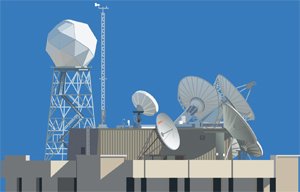 |
Director's NoteTom Achtor |
NSF Science and Technology Center Proposal
The National Science Foundation sponsors a program to create Science and Technology Centers (STC) that support innovative, potentially transformative, complex research and education projects that require large-scale, long-term awards. STCs conduct world-class research through partnerships among academic institutions, national laboratories, industrial organizations, and/or other public/private entities. They provide a means to undertake significant investigations at the interfaces of disciplines and/or fresh approaches within disciplines.
Greg Tripoli has assembled a broad-based team of experts from several disciplines, won a campus competition and recently submitted a pre-proposal to create a NSF STC on the UW-Madison campus with SSEC as the administrative home. Hank Revercomb, Steve Ackerman and several SSEC scientists are Co-Investigators on the proposal effort.
The pre-proposal presents an innovative approach to be taken by the “Earth5D” proposal to embrace and utilize the emerging technologies of electronic information transfer and machine learning in order to incorporate weather information contained in a Probabilistic 5D Information Grid (P5DIG) directly into infrastructure and personal computing devices. This revolutionary approach will enable Earth5D to utilize machine learning and artificial intelligence to build electronic control and advisory systems that fully tap the P5DIG. This will open up pathways that make weather information more useful to society by integrating the information directly into infrastructure control systems and the public’s own personal computer, navigation or other control systems.
This collaboration will bring together world class programs of SSEC’s satellite research and the Doppler radar program developed under the leadership of proposal Co-PI Chandra Chandrasekar (Colorado State University), and marry them to Professor Tripoli’s strong numerical modeling and data assimilation program. Combining these programs with artificial intelligence will enable the STC to tackle what has become one of the most difficult hurdles facing atmospheric science in 100 years, i.e. how to move toward full probabilistic prediction. Adding powerful industrial partners like Weather Central and Microsoft to the partnership adds significant expertise and experience.
Selection of candidates to move to the proposal level will be announced in October, with proposals due in February 2012. If selected, the proposal activities will create very significant changes to our corner of the campus.
Preparing for next generation environmental satellites
CIMSS and NOAA/ASPB scientists have been working for several years on the development and delivery of software that creates products from the forthcoming GOES-R+ systems. These algorithms take advantage of the higher spatial and temporal resolution, plus the additional spectral coverage of the GOES-R Advanced Baseline Imager (ABI) instrument. Over the past year the CIMSS/ASPB teams have delivered the algorithm theoretical basis documents (ATBD) and software with validation data sets for almost half of the 64 level one and level two products. This year the Center will receive over $5M in funding to support the GOES-R+ Algorithm Working Group, Proving Ground, Risk Reduction and High Impact Weather projects. The annual meeting will be held June 14-16 this year in Fort Collins, CO.
The biggest change in the US operational satellite program is the termination of the NPOESS (polar orbiting satellite) program, moving the civilian side, now called the Joint Polar Satellite System (JPSS), to a more traditional NASA/NOAA partnership. However, a major problem emerged this year as splitting the NPOESS Program into civilian and military elements left JPSS with a severe funding shortage. Given the current political situation, efforts to add more funding to JPSS this year didn’t happen. The result is NOAA has taken on a major new program with less than half the funding needed, and the result for the Center is several of our polar science projects are working with reduced funding levels to get to next year. What further compounds the problem is the first satellite of this series, still called NPP (for NPOESS Preparatory Program), is scheduled for launch in October of this year. This is good news but the lack of funding to better support NPP this year is not. NASA/NOAA are funding those JPSS programs that are most closely related to pre and post launch instrument and data requirements. Thus our work with the VIIRS (imager) and CrIS (sounder) instruments support and our work with validation of key products continues to be fully supported. Projects more focused on new products and science will hopefully be fully funded again in FY2012. Our support for the NPP/JPSS program remains vital to program success.
